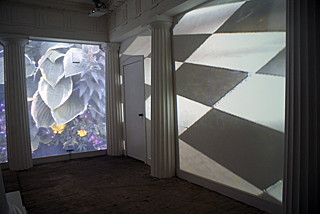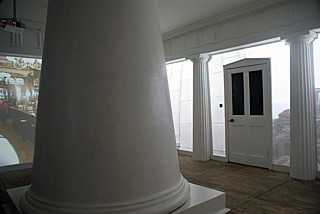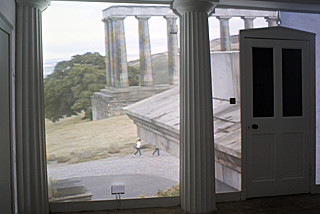On Staged
Kim Coleman & Jenny Hogarth
At last year’s Frieze Art Fair, Kim Coleman and Jenny Hogarth’s project Players, sat smartly alongside other works that intended to critique their environs by creating an alternative portrait of the fair itself. Ryan Gander set-up an ad hoc photography studio that took and displayed portraits of the exposition visitors, whilst Stephanie Syjuco’s ‘parasitic workshop’ made and sold bootleg copies of the works exhibited elsewhere at the fair. For Players, Coleman and Hogarth creating a meta-referential, Kaufman-esque world-within-a-world, accessed by visitors through a miniature copy of the fair’s main entrance. Inside, projected onto plush encircling textiles was a delicately ambiguous combination of live and pre-recorded action from the fair outwith. The footage, edited live onsite, included planted actors blending into the crowd- occasionally offering a cheeky revelatory wink towards the camera. This conscious multi-layered blurring of the real and fiction worked to leave viewers unsure of who or what could be trusted as truth, creating an experience that was immersive, disorienting and compelling.
With its similar theoretical and conceptual roots, I climbed Calton Hill looking forward to seeing how Staged revisited and recontextualised these ideas for the Edinburgh Arts Festival. Reading the accompanying material prompted pre-emptive thoughts of films such as Red Road and Rear Window- the viewer being offered a heightened position of privilege over the city and its inhabitants, surveying a world with potential for anything to happen- cast as active voyeur or amateur sleuth. In addition, the artists’ citation of Jaques Tati’s Playtime as an influence prompted assumption of engrossing action and jocular tone. From the first visit however, Staged proved to be a very different proposition.
The viewer’s role was more that of passive spectator, the pace slow and the potential for action and remarkable incident seemed remote. The parameters were set with stricter rigidity- the playful, sinister atmosphere of Players replaced by a far more sober feel. Everything in Staged was presented as fact. Multiple, simultaneous truths, and unfiltered reality that lacked the dynamic uncertainty central to Players. Discussions overheard in the observatory focused far more on the technical concerns in creating the work and the history of the host building itself- rather than the content and inference of the offered visuals. With a sense of mild disappointment I returned down the hill and back into the real city.
The second time I visited Staged I noted the fact that the work was entered through a heavy curtain- this lent an air of theatricality to the experience and recalled Terence Davies’ documentaryfilm Of Time and the City, where the footage of his beloved Liverpool is entered virtually through the opening of a theatre curtain. Like Staged, Of Time in the City represents an intimate portrait of a city from a native- however whilst Davies’ love-letter to Liverpool is rambling, passionate and tempestuous- full of romantic hyperbole and frustration, Coleman and Hogarth’s homage to Edinburgh is quiet, pensive and measured- it requires reading and rereading for it to get under the skin.
The relationship between Staged and festival-time Edinburgh, where ‘people come to see performances and at the same time form part of a human drama’ has been widely discussed. However, in Staged the city is given priority as the main protagonist, whilst its inhabitants are given secondary importance, lazing absently on the grass or crossing a distant road. The sounds of the city during the festival are also neglected- the works silence allowing and prompting reflection and contemplation. Rather than portraying the Edinburgh of the festival, Staged provides a pleasing and welcome counterpoint to it. It is the Edinburgh of the rest of the year, without the tourist hoards and manufactured noise. Here, Tati’s Playtime is subtly evoked. There are moments in the film, amidst the elongated scenes of drone-like tourists absently milling around Tati’s futuristic Paris, when the city of old (The Eiffel Tower, Notre Dame de Paris) is reflected in the windows and glass doors of the future prognosis. These fleeting glimpses act as a poignant reference to the city of the past- that has been overrun and superseded. Similarly, the Edinburgh depicted in Staged is the city of old, and the city that will thankfully resurface once the carnival has passed on.
(An interesting coincidence has seen an old Tati script realized in The Illusionist, which opened the Edinburgh film festival. The animated film, set mainly in Edinburgh, presents a beautifully hand-drawn, meticulously intimate depiction of the city.)
The final time I visited Staged was on one of those rare, prized days of scorching sunshine when walking amidst the city centre throng becomes even more disagreeable. The work provided relief from both the heat and the crowds and felt made for the cities locals at a time when they are swept along, or swept aside by the transient hoards. It has the feel of having been made by locals for locals, providing an intimate view of Edinburgh from a knowing insider, with references that go deeper that the touristic façade- the iconic interior of the Scotsman building to the homely warmth of the Café Royal bar. Coleman and Hogarth have created a sanctuary on the hill, where visitors can re-appreciate the day-to-day surroundings that are taken for granted and reflect upon their place within, and their relationship to, the city they call home.
‘We weave our memories into a palimpsest of dreams where time and place melt into each other. Memories become maps through places which we can never return in a world that is changing all around us.’ Matthew Gandy.
All images
Kim Coleman & Jenny Hogarth
Staged, installation view, City Observatory, Calton Hill, Edinburgh, 2010
Courtesy of the artist

















Comments